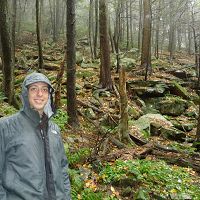Duffy et al., 2016
Using Isotopic Age of Water as a Constraint on Model Identification at the Critical Zone Observatory (Invited)
Duffy, C., Thomas, E., Bhatt, G., Holmes, G., Boyer, E.W., and Sullivan, P. (2016)
2016 Fall Meeting, American Geophysical Union, San Francisco, CA, 12-16 Dec.
-
Shale Hills, INVESTIGATOR
-
Shale Hills, GRAD STUDENT
-
Shale Hills, GRAD STUDENT
-
Calhoun, Shale Hills, INVESTIGATOR, COLLABORATOR
Abstract
This paper presents an ecohydrologic model constrained by comprehensive space and time observations of water and stable isotopes of oxygen and hydrogen for an upland catchment, the Susquehanna/Shale Hills Critical Zone Observatory (SSH_CZO). The paper first develops the theoretical basis for simulation of flow, isotope ratios and “age” as water moves through the canopy, to the unsaturated and saturated zones and finally to an intermittent stream. The model formulation demonstrates that the residence time and age of environmental tracers can be directly simulated without knowledge of the form of the underlying residence time distribution function and without the addition of any new physical parameters.
The model is used to explore the observed rapid attenuation of event and seasonal isotopic ratios in precipitation over the depth of the soil zone and the impact of decreasing hydraulic conductivity with depth on the dynamics of streamflow and stream isotope ratios. The results suggest the importance of mobile macropore flow on recharge to groundwater during the non-growing cold-wet season. The soil matrix is also recharged during this season with a cold-season isotope signature. During the growing-dry season, root uptake and evaporation from the soil matrix along with a declining water table provides the main source of water for plants and determines the growing season signature. Flow path changes during storm events and transient overland flow is inferred by comparing the frequency distribution of groundwater and stream isotope histories with model results. Model uncertainty is evaluated for conditions of matrix-macropore partitioning and heterogeneous variations in conductivity with depth. The paper concludes by comparing the fully dynamical model with the simplified mixing model form in dynamic equilibrium. The comparison illustrates the importance of system memory on the time scales for flow and mixing processes and the limitations of the dynamic equilibrium assumption on estimated age and residence time.
Citation
Duffy, C., Thomas, E., Bhatt, G., Holmes, G., Boyer, E.W., and Sullivan, P. (2016): Using Isotopic Age of Water as a Constraint on Model Identification at the Critical Zone Observatory (Invited). 2016 Fall Meeting, American Geophysical Union, San Francisco, CA, 12-16 Dec..
 This Paper/Book acknowledges NSF CZO grant support.
This Paper/Book acknowledges NSF CZO grant support.
Explore Further





